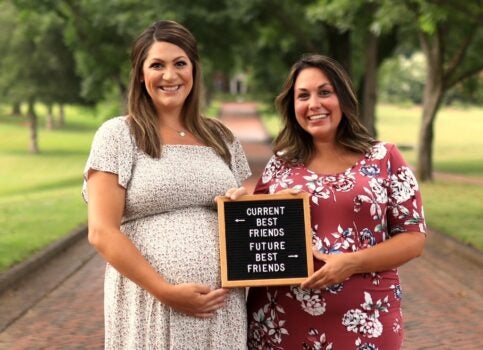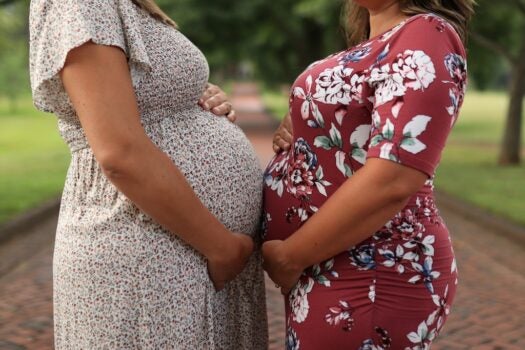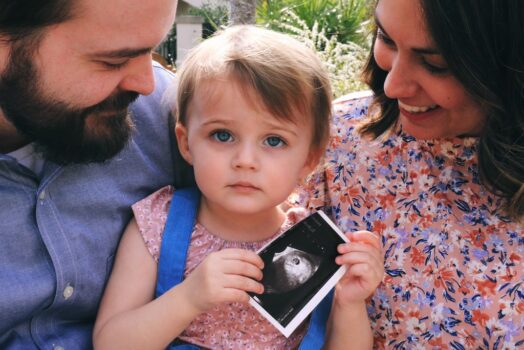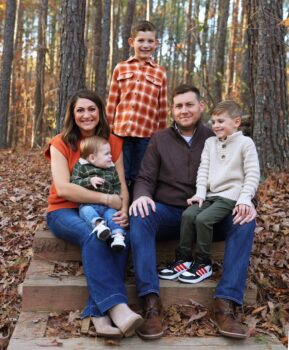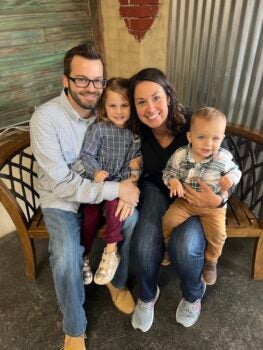Fighting for family: Two Shelby County moms share their IVF journey
Published 10:17 am Monday, April 1, 2024
|
Getting your Trinity Audio player ready...
|
By MACKENZEE SIMMS | Staff Writer
One summer, two friends went on a vacation to the beach together with their husbands. Unbeknownst to each other, both Helena High School English teacher Cassie Screws and Calera Elementary School ESL teacher Casey Ford were each facing an all too common issue plaguing women around the world. They were both silently struggling with infertility.
“I remember that Cassie was kind of upset while we were at the beach,” Casey said. “I asked what’s going on? And she said, We’ve been trying for a year, we haven’t been able to get pregnant. And I was like, ‘Oh my God me too.’”
For the two friends, this conversation was more than venting—It bonded them closer together.
“It turned into something more,” Casey said. “We were just kind of more open with each other. We had known each other for a couple of years, but that kind of like brought us closer together.”
After that day at the beach, the two friends shared their burdens, offered support and approached the journey to parenthood together. What followed was an entwined narrative of heartache and indescribable joy, culminating into two families grown larger through in vitro fertilization.
A LONG ROAD AHEAD
Cassie and her husband, Brian, first met when she moved to Alabaster to start her freshman year at Thompson High School. After dating for eight years, Cassie shared that the couple made the decision to start trying to conceive fairly soon after getting married.
“By the time we were ready to get married, we were pretty close to wanting to start our family at that point, so it didn’t take long before we started trying,” she said. “And then a year goes by, nothing’s happening. Two years go by and nothing’s happening. We start to see an infertility specialist at that point.”
Cassie did not begin her journey with traditional IVF, but rather opted for the less invasive—and less expensive—intrauterine insemination (IUI). With IUI, the doctor places a concentrated sperm sample into the uterus. Cassie tried IUI a total of eight times, and although three of these inseminations resulted in pregnancies, she lost all three babies early.
After eight IUIs over the course of four years, the Screws family decided to try IVF at Alabama Fertility Specialists with Dr. Karen Hammond.
For most women, the IVF process begins with rounds of medication that contain follicle stimulating hormones meant to encourage the body to develop more than one egg per month and hormones to help the eggs mature. Then, women will undergo a surgical procedure to retrieve the eggs. After the eggs are retrieved, the eggs are fertilized with the sperm sample. The fertilized eggs are then transferred into the uterus to give the eggs a chance to implant.
But for Cassie, this IVF cycle was never completed.
She began the process of medications and monitoring, but found out she was pregnant before she underwent the egg retrieval. Although Cassie technically did not undergo IVF for her first child, she claims that she still wouldn’t have gotten pregnant without medical intervention and attributes the pregnancy to the medications and hormones taken during the first stages of her treatment.
“I don’t ovulate on my own, so I had to have the gonadotrophins in order to produce eggs that were mature enough to conceive,” Cassie said.
After almost four years of fertility treatments, this pregnancy resulted in the birth of Judah Screws on Nov. 16, 2016.
NOT FIGHTING ALONE
Meanwhile, Casey was also undergoing treatment of her own.
When her regular obstetrician first mentioned that she might be experiencing infertility, Casey recalls disregarding the informational pamphlet.
“’I don’t need this crap,’” she said. “I’m 24 years old. I don’t need fertility (treatments). My mom had four kids, so I didn’t really think anything of it.”
But after trying to conceive for some time without success, Casey began to receive treatment at Alabama Reproductive Technologies in 2014. There, she was told that she would likely only get pregnant through IVF. Despite this prognosis, Casey discovered that she was pregnant nearly one week after this appointment.
“We got pregnant, like a week later, and I was like, ‘See, I told you we didn’t need (IVF),’” she said. “We end up losing that baby at the end of June. I didn’t even make it six weeks.”
Prior to the miscarriage, Casey and her husband, Steven, already shared the news of their pregnancy to both sets of parents, Cassie and a few coworkers. Even though many people will recommend that expectant parents not share the news about their pregnancy until a large portion of the first trimester has passed, Casey shared that she regretted not telling more people.
“I regretted not telling more people as weird as that sounds because people were coming up to me and like, ‘Hey, how’s it going,’” she said. “I was like, ‘I’m not okay.’ I can’t. I don’t need you to treat me like everything’s normal because my world just ended.”
After this, Casey attended an infertility small group with Cassie where she met Hammond, the same care provider treating Cassie. After meeting Hammond, Casey changed practices and followed her to Alabama Fertility Specialists. Under Dr. Beth Malizia, Casey underwent six rounds of IUIs, none of which were successful.
The Ford family elected to start with IUIs because they were covered by their health insurance and the IVF process was not, For them, IVF would lead to around a $15,000 cost before considering the price of medication and hormones.
When the Fords decided they wanted to try IVF, they turned to their community to help fundraise. In addition to selling T-shirts emblazoned with the phrase “Journey to Baby Ford” on the front and “It takes a village” on the back, the Ford family also raised money through community yard sales and a carwash at Autozone.
“Our community was incredible in helping us,” Casey said. “People came together, and we ended up raising like $8,000 toward it. It was it was a great chunk, and it was extremely helpful.”
On July 25, 2017, Casey successfully had four eggs retrieved. Three days later, two of the fertilized eggs were implanted and two were left to go into storage. Not only did these inseminations fail, the other two eggs that were supposed to go to storage were lost as well.
TRYING AGAIN
Meanwhile, Cassie had welcomed her son, Judah, into the world. During her pregnancy, Cassie shared that she thought she would be perfectly content with one child. But after Judah was born, her thoughts began to shift.
“Once I had my oldest, I thought I was going to be happy with one, but I really, really wanted another baby,” she said. “I really wanted to have a sibling for Judah.”
For her second pregnancy, Cassie did not want to wait and elected to start undergoing IVF right away. After following Hammond to the Alabama Institute of Reproductive Medicine, Cassie decided to try a different IVF protocol called INVOcell in the summer of 2018.
In traditional IVF, once the eggs are retrieved, they are fertilized and developed in a lab environment before being implanted into the uterus. INVOcell involves a small, intrauterine device that serves as an intravaginal culture. Once the eggs are retrieved, they are placed inside the device and inserted into the uterus.
With INVOcell, the fertilization of the egg, and the subsequent incubation period, occurs inside the uterus, rather than a lab. After this period, the embryos are removed from the device. Some eggs are then transferred back into the uterus for implantation while the remaining eggs are placed in storage.
Using this method, Cassie became pregnant with her second son, Parker, under the care of Dr. Cecil Long and Hammond. She added that Parker was the first baby conceived via INVOcell at the Alabama Institute of Reproductive Medicine. Parker Screws was born on Feb. 7, 2019.
“We were very, very lucky and very grateful that we only had to do one round of IVF with Parker after eight IUIs in four years for Judah,” Cassie said. “INVOcell really changes the game for IVF, too, because you’re not having to create dozens of eggs and then see what happens and then implant and see what happens.”
A NEW HOPE
Casey also elected to follow Hammond to the Alabama Institute of Reproductive Medicine to try a round of INVOcell in June of 2018. And while this process was successful for her friend, it did not result in Casey getting pregnant.
“Cassie and I ended up going through with this (INVOcell) process at the same time and we were really excited, and she found out that she got pregnant and I did not,” Casey said. “It was one of the hardest things I’ve ever done in my life. She was my best friend and I wanted to be happy for her, and I was happy for her, but I was so sad for me. It was really difficult.”
The two friends developed a code to discuss any topics related to pregnancy, and according to Casey, she could not have asked for a more understanding friend during a difficult time.
In August of 2018, Casey rushed to do another round of IVF which once again did not result in a pregnancy.
“I got the news that it was negative and then I had to go to work and be the happy teacher on the first day of school,” she said. “It was awful.”
That school year, Casey threw herself into work as a distraction.
“I felt like I had nothing at home, so I just threw myself into my job and had an amazing school year,” she said. “We had so much fun that year, but I still felt completely empty. Completely broken.”
After having some difficult conversations regarding finances, the Fords decided to try IVF one last time in June of 2019. They once again elected to use INVOcell under Hammond’s care.
Ten eggs were retrieved, but only nine were mature. These nine eggs were fertilized and placed inside the INVOcell device in the uterus. When the device was retrieved, only three of these nine eggs remained, two of excellent quality and one of okay quality.
Casey had two eggs implanted, one excellent quality and the one okay quality, while the other excellent quality egg went into storage.
Then, after four cycles of IVF and six rounds of IUIs, Casey Ford became pregnant.
BUILDING A FAMILY
Nora Jane Ford was born in February 2020, right before the beginning of quarantine for the COVID-19 pandemic. After struggling to conceive for so long, Casey shared that she was shocked by the realities of being a first-time parent and that she struggled with post-partum depression.
“It was a change that I never expected because I knew everything about how to get pregnant or how to try to get pregnant, but I knew nothing really about how to be a mom or how different my life would be after she was here,” she said. “It was unexpected. And because I was infertile, I had thought that (postpartum depression) would never happen to me because I worked so hard to get her here.”
Casey never wavered in her love for her daughter, but struggled to adapt to motherhood in the uncertain world caused by the pandemic. She couldn’t go to Target and wander the aisles with friends or go to Disney World, or do any of the things that might make her feel normal.
Despite the initial difficulties, she adapted and when her daughter was 18 months old, her and her husband revisited the idea of having another kid. Their attention turned to the one surviving egg they had in storage.
“When we made the decision to put the one in the freezer, I told myself—because I had to—that we had no more babies,” Casey said. “We had no eggs. We had nothing. Because I could not let myself think that I could ever have another one. I could not go through that again. I could not put myself in that position. So I raised Nora, as if she was going to be an only child.”
But in 2021, the Fords decided to place all of their hope for a second child with the one surviving egg. They called Hammond, who had left Alabama Institute of Reproductive Medicine for Innovative Fertility Specialists, and Hammond explained the process of transferring the egg—now in a freezer tank—to a new clinic.
During this process, Casey received a call from Cassie with some surprising news. After two children born through medical intervention, she was pregnant via natural conception.
“She was freaking out and I was just laughing because I was about to be pregnant too,” Casey said. “It was just such a full circle moment. I was carrying that freezer tank with Nash inside thinking Cassie is pregnant and I’m about to be too.”
Casey explained that she approached this frozen embryo transfer with a different attitude. She believed that she was going to get pregnant, no ifs or buts.
“I wasn’t going to let myself think anything else can happen,” She said. “I was going to be pregnant. That’s the mindset I had. There was no thought in my mind that it wasn’t going to happen that time. It just felt completely different.”
On Jan. 24, 2022, the final egg was implanted and resulted in a pregnancy.
In 2022, both Cassie and Casey were pregnant at the same time. After years of struggling with infertility and IVF, the two friends could look back on the beach vacation where they first poured their hearts out to each other and smile.
“It’s just incredible to think that we never thought that we would get that,” Casey said. “We never thought that we would be pregnant at the same time, have maternity pictures together at the same time. That just blows my mind.”
Knox Screws was born on July 27, 2022, with Nash Ford following 10 weeks later on October 6, 2022.
THE IMPACT ON THEIR LIVES
Although her final child was conceived naturally, Cassie expressed her belief that IVF has been a blessing upon her life.
“Knowing the value that my kids bring to me and the gift and the miracle of science and IVF, it’s really amazing that I have what I have,” she said.
After her eight-year journey, Casey shared that she is eternally grateful for IVF and Dr. Hammond for her children.
“I wouldn’t be a mom without (Hammond),” she said. “I knew from the moment I met her that she was going to change my life. And I just don’t know what it would be like without her. I’m endlessly grateful.”
The stories of Cassie and Casey are just two among the hundreds of thousands of women who undergo these types of fertility treatments every year. It is through medical advancements and treatments like IVF that children like Parker, Nora and Nash are born each and every day to welcoming families that are unable to conceive naturally.
On Feb. 16, 2024, The Alabama Supreme Court issued a ruling declaring that embryos created through IVF should be considered children. The court issued this ruling in response to a wrongful death case brought by three families whose frozen embryos were destroyed in a lab accident at the Center for Reproductive Medicine.
All three families kept embryos frozen in the center’s cryogenic nursery. In December 2022, a patient entered the nursery and dropped the containers of embryos, destroying them. The families then sued the Center for Reproductive Medicine and the center’s owners, the Mobile Infirmary Association, for charges including wrongful death of a minor, and if the embryos did not qualify as minors, they presented the alternative charges such as common-law claims of negligence.
The Alabama Supreme Court ruled that in this case, and subsequently all cases, frozen embryos do qualify as children under the Wrongful Death of a Minor Act.
Following this decision, several IVF clinics around the state paused all IVF services out of uncertainty surrounding the ramifications of this decision, sparking outcry from the public.
On Feb. 26, Hammond, the same provider that treated Cassie and Casey, posted a statement on Facebook, responding to the Supreme Court decision.
“This ruling has significantly impacted the ability for patients seeking care in Alabama to undergo IVF procedures,” Hammond said. “We absolutely believe that embryos are precious hopes for pregnancy. We are also realistic in the knowledge that not every IVF cycle, nor every embryo transfer, results in a pregnancy.”
In that same post, Hammond shared that she wholeheartedly respects every decision that Alabama practices have made regarding whether to continue IVF services, but she believes that the only thing worse than struggling with infertility is to be denied access to care. Innovative Fertility Specialists made the decision to continue with IVF services for their patients.
Casey reacted to the court case itself with immediate sympathy, but struggled to understand the Alabama Supreme Court’s decision.
“I could not imagine if I had embryos destroyed,” She said. “I knew, for us, literally all our eggs were in that last basket. It’s devastating for them, and I don’t want to take away from the loss that they suffered.”
The news of the case caused Casey to reflect on her own experiences. During her journey, she lost 14 embryos. These losses were devastating for her because of the potential they represented.
“Anyone who’s lost a pregnancy or a baby, they understand that you lose birthdays,” Casey said. “You lose graduations, you lose wedding dates, you lose those things when you lose a baby or an embryo…but calling them children I think was a stretch for me personally.”
Self-described as being pro-life, Cassie shared that she believes that IVF is part of giving life and that people do not go into IVF that don’t believe that life is valuable. For her, the most upsetting part about the recent discourse surrounding IVF is that people want to claim that the status of an embryo is a black or white issue.
“People want to say it’s either black and white, and it’s not. IVF is not black or white,” she said. “An embryo is like a seed. All the potential is there, all the hope for baby is there, but without a place to plant it, nothing is going to happen to it.”
The Alabama Supreme Court ruling which resulted in the cessation of treatment at different Alabama fertility facilities had a broad impact on families across the state. It not only meant that planned procedures could not continue, it also affected every woman taking hormones to prepare for an IVF cycle.
For Casey, the most upsetting part of the Alabama Supreme Court decision was that those behind the decision were able to pass judgement on an issue they had no personal experience with.
“People who don’t have a dog in the fight, got to sit in an office in Montgomery and make a decision that potentially cost thousands of people thousands of dollars without a second thought,” she said. “I think it was very rash of the people that we trusted in those positions to make that decision, without considering the consequences for everyone involved.”
On March 6, Gov. Kay Ivey passed a bill into law that aimed to protect IVF clinics from criminal and civil charges relating to the Alabama Supreme Court’s decision. This bill was created with the hope of encouraging IVF clinics to resume services.
“The overwhelming support of SB159 from the Alabama Legislature proves what we have been saying: Alabama works to foster a culture of life, and that certainly includes IVF,” Ivey said in a statement. “I am pleased to sign this important, short-term measure into law so that couples in Alabama hoping and praying to be parents can grow their families through IVF.”
The passage of this bill resulted in Alabama IVF clinics resuming services to the relief of many.
“I think the first step was the bill that Gov. Ivey signed,” Cassie said. “It is a step in the right direction, allowing clinics and doctors to do what they know and what they know best.”
Nevertheless, the long-term implications of the Alabama Supreme Court decision are still unknown, and the future of IVF hangs on a thread of uncertainty.
“I would not be who I am or where I am without IVF,” Casey said. “The fact that people are trying to limit that is beyond me.”


